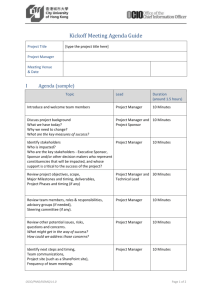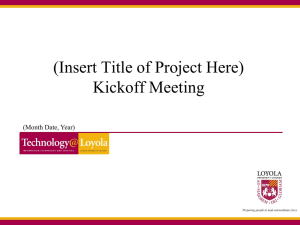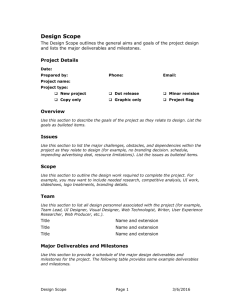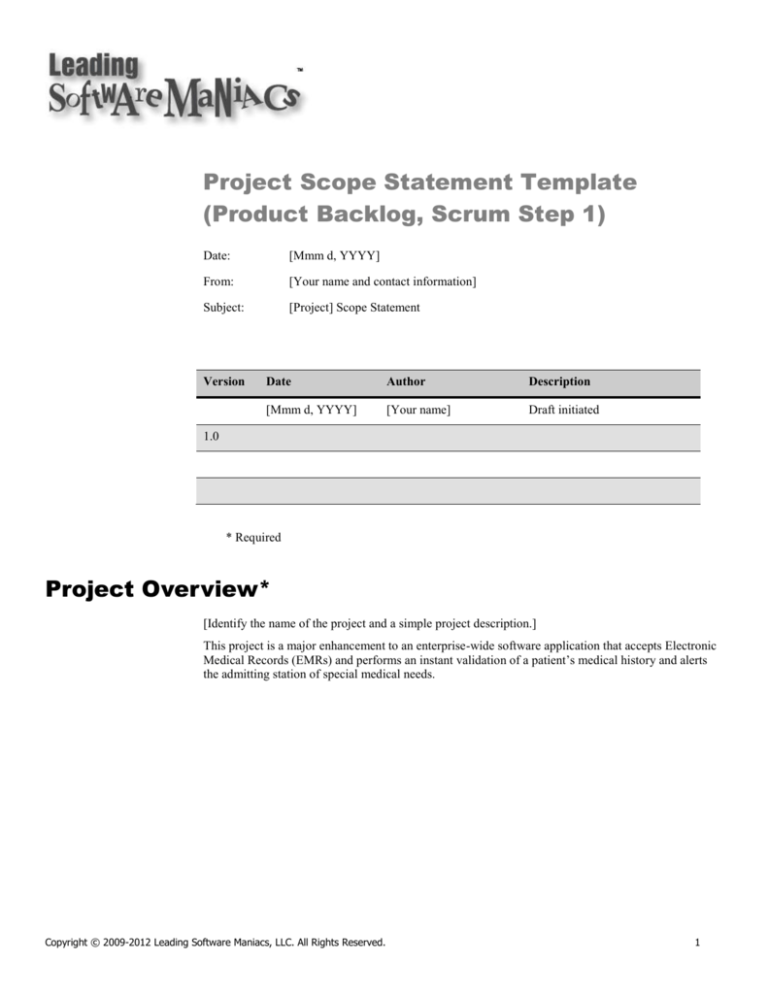
Project Scope Statement Template
(Product Backlog, Scrum Step 1)
Date:
[Mmm d, YYYY]
From:
[Your name and contact information]
Subject:
[Project] Scope Statement
Version
Date
Author
Description
[Mmm d, YYYY]
[Your name]
Draft initiated
1.0
* Required
Project Overview*
[Identify the name of the project and a simple project description.]
This project is a major enhancement to an enterprise-wide software application that accepts Electronic
Medical Records (EMRs) and performs an instant validation of a patient’s medical history and alerts
the admitting station of special medical needs.
Copyright © 2009-2012 Leading Software Maniacs, LLC. All Rights Reserved.
11
1
Project Objectives*
[Identify overall project objectives in terms that is represented in some form of a measurable success
criteria (which usually refers to the Triple Constraint: time, costs, scope, and optionally quality).]
Due to conformance to new state healthcare regulations, this software enhancement must be released
by the end of the fiscal year. Since this represents major new feature sets and benefits to the patient and
to the payer, the software should be able to charge a ten percent revenue premium to the current retail
price. The information retrieved must have a higher degree of quality validation to ensure that the right
information is returned for the patient and that the information can be retrieved in less than ten seconds
(regardless of the size of the patient database).
Product Scope Description*
[Overall definition and characteristics of the software product feature and function set.]
The software will run on PCs running Windows XP and Vista and will support the retrieval of
information of all patients that have been admitted in a hospital over the past five years. The built-in
tutorials are designed to provide instruction to a new user so that they are productive within the first 30
minutes of use.
Feature
(PB)
Description
MH
Min
MW
Max
MW
COM
1.0
Feature 1
description
2.0
Feature 2
description
COR
FEA
NEC
TRA
VER
PB=Product Backlog Item, MH=Must Have (otherwise, Nice to Have)
COM=Complete,COR=Correct,FEA=Feasible,NEC=Necessary,TRA=Traceable,VER=Verifiable.
Project Boundaries
[Usually identifies requirements that are NOT included in this release.]
One of the needs by the user stakeholders is project reporting of aggregated condition for the day
which can show trends of conditions for repeat visits. The focus on this release is to retrieve the
information in a timely manner at check in, future releases will provide more reporting services.
Copyright © 2009-2012 Leading Software Maniacs, LLC. All Rights Reserved.
2
Project Deliverables
[Product and project deliverables.]
Product deliverables are: the software application (updated), new user on-line documentation, and
availability for distribution using a secure access on company’s Web site.
Project deliverables are: test plan and test reports, Change Requests, schedule, WBS, and lessons
learned.
Product Acceptance Criteria*
[Overview of how you’ll know that stakeholder’s requirements have been validated.]
Each new feature is expected to have a corresponding quality test plan associated with it that is
approved by engineering. During the testing phase during project life cycle, defects will be judged
based on priority and severity with the team deciding on which defects are corrected.
To be considered for release, the most important milestone is to meet Technical Feasibility on
schedule. Contrary to other projects in the past, the QA (test) team will be engaged at the start of the
project to ensure that quality standards for this release are met.
Project Constraints*
[Identify key known limitations—usually time, cost, and other factors that have a direct impact on
Scope (the Triple Constraint).]
This is not the time to introduce a new user interface (UI), so the screens showing the new medical
alerts must be the same style as the prior version’s look and feel.
Project Assumptions*
[Identify what you think are true.]
Resources during development are expected to be a subset of the original team that created the product.
Identified Risks*
[Although not to the level of the Risk Management Plan, identify a few key Risks that can directly
impact the Project Objectives.]
Key risks for this project are:
Not getting the resources on board on time by June 1st
Achieving Technical Feasibility on schedule
Not assuring that performance goals can be met soon after the design period
Copyright © 2009-2012 Leading Software Maniacs, LLC. All Rights Reserved.
3
Schedule Milestones*
[Identify key milestones (most practically, these are ranges initially).]
Basic schedule range is expected to be:
Technical Feasibility
Oct 15-Oct 22
Release
Nov 15-Dec 15
Cost Estimate
[Estimate the range of costs as well as any funding limitations (don’t forget maintenance efforts after
delivery!).]
The budget is assumed to be in the $250K-$300K range (internal costs with benefits). Anything above
that range requires at least a two week notification with Finance.
Project Specification
[Identify specific project and product documents that will be developed for this project.]
A Marketing Requirements Document (MRD) is to be created that outlines each approved
Requirement. Also, there will be a design and implementation guide written by engineering as soon as
the team exits the initial Planning process (Planning Complete).
Approval Requirements
[Identification of approval authorities.]
Milestones can be approved by engineering and QA leadership, key project documents to approved by
engineering, product management, and QA leadership with the exception that Release needs to be
approved by upper management.
Acceptance
Submitter’s signature
Sponsor’s signature
[Your name]
[Sponsor’s name]
Copyright © 2009-2012 Leading Software Maniacs, LLC. All Rights Reserved.
4
[Your title]
[Sponsor’s title]
Date submitted
Date accepted
Copyright © 2009-2012 Leading Software Maniacs, LLC. All Rights Reserved.
5


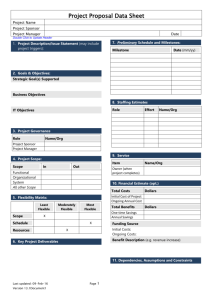
![Your_Solutions_LLC_-_New_Business3[1]](http://s2.studylib.net/store/data/005544494_1-444a738d95c4d66d28ef7ef4e25c86f0-300x300.png)
